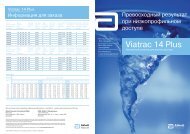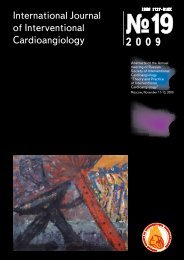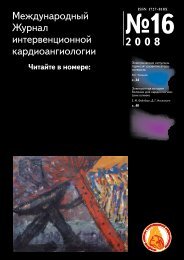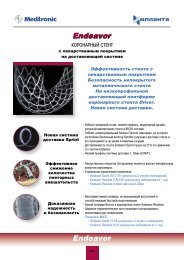Results of Coronary Stenting using the Stents with
Results of Coronary Stenting using the Stents with
Results of Coronary Stenting using the Stents with
Create successful ePaper yourself
Turn your PDF publications into a flip-book with our unique Google optimized e-Paper software.
Miscellaneous<br />
• Type 2: one bronchial artery arises to <strong>the</strong> left,<br />
and one intercostal bronchial artery — to <strong>the</strong> right <strong>of</strong><br />
<strong>the</strong> aorta — in 20% <strong>of</strong> cases.<br />
• Type 3: two bronchial arteries arise to <strong>the</strong> left,<br />
and one bronchial and one intercostal bronchial artery<br />
— to <strong>the</strong> right <strong>of</strong> <strong>the</strong> aorta — in 20% <strong>of</strong> cases..<br />
• Type 4: one bronchial artery arises to <strong>the</strong> left,<br />
and и one bronchial and one intercostal bronchial<br />
artery — to <strong>the</strong> right <strong>of</strong> <strong>the</strong> aorta — in 10% <strong>of</strong> cases.<br />
However <strong>the</strong>re are many variants <strong>of</strong> bronchial arteries<br />
origin. They can arise from <strong>the</strong> aortic arch, <strong>the</strong><br />
internal thoracic artery, <strong>the</strong> thyrocervical trunk, <strong>the</strong><br />
left subclavian artery, <strong>the</strong> inferior thyroid artery and<br />
<strong>the</strong> abdominal aorta (11). Bronchial arteries have a<br />
lot <strong>of</strong> collaterals <strong>with</strong> o<strong>the</strong>r anatomic areas, which has<br />
to be taken into consideration while performing <strong>the</strong><br />
embolization. The most important are <strong>the</strong> collaterals<br />
to <strong>the</strong> anterior cerebral artery supplying <strong>the</strong> spinal<br />
cord, <strong>the</strong> right and <strong>the</strong> left subclavian arteries and <strong>the</strong><br />
right coronary artery.<br />
The embolization <strong>of</strong> a bronchial artery was first<br />
described by Remy (12) in 1970, and <strong>with</strong> <strong>the</strong> course<br />
<strong>of</strong> time became <strong>the</strong> generally adopted method for <strong>the</strong><br />
treatment <strong>of</strong> massive pulmonary bleeding (13-16).<br />
Technical improvements in ca<strong>the</strong>ters’ design and<br />
production methods, as well as in embolizing materials<br />
have contributed to <strong>the</strong> enhancement <strong>of</strong> safety<br />
and availability <strong>of</strong> this procedure. The search <strong>of</strong> <strong>the</strong><br />
source <strong>of</strong> pulmonary bleeding during angiographic<br />
examination should be started <strong>with</strong> thoracic angiography.<br />
At <strong>the</strong> next stage selective ca<strong>the</strong>terization <strong>of</strong><br />
bronchial arteries is performed. It can be done <strong>with</strong><br />
<strong>the</strong> use <strong>of</strong> ca<strong>the</strong>ters like Cobra, Simmons, Mammary,<br />
Multi-purpose, as well as <strong>of</strong> special ca<strong>the</strong>ters for<br />
bronchial arteries. If lateral branches arising from <strong>the</strong><br />
bronchial artery supply o<strong>the</strong>r anatomical areas, superselective<br />
embolization <strong>using</strong> microca<strong>the</strong>ter is performed,<br />
because <strong>the</strong> embolization <strong>of</strong> <strong>the</strong>se branches<br />
can lead to complications.<br />
Hemostatic sponge, microspheres and coils can<br />
be used as embolization material. The main advantage<br />
<strong>of</strong> a hemostatic sponge consists in its availability<br />
and low cost. However <strong>with</strong> <strong>the</strong> course <strong>of</strong> time <strong>the</strong><br />
sponge resolves which can lead to recanalization <strong>of</strong><br />
<strong>the</strong> embolized vessel and recurrent bleeding. Thus,<br />
hemostatic sponge can be used only for temporary<br />
bleeding control. The most frequently used embolizing<br />
material are PVA particles. Being biocompatible<br />
and non-biodegradable <strong>the</strong>y provide long-term<br />
hemostasis (17). Recently it was suggested to use<br />
for this purpose <strong>the</strong> embospheres produced on <strong>the</strong><br />
basis <strong>of</strong> triacryl gelatine, however <strong>the</strong> experience<br />
<strong>with</strong> <strong>the</strong> use <strong>of</strong> this material for bronchial arteries<br />
embolization is still limited. The main advantage <strong>of</strong><br />
embospheres over <strong>the</strong> PVA particles consists in <strong>the</strong>ir<br />
better penetrating capacity and <strong>the</strong> lack <strong>of</strong> propensity<br />
for clots formation due to particles’ glueing, which is<br />
especially important <strong>with</strong> <strong>the</strong> use <strong>of</strong> microca<strong>the</strong>ters.<br />
As a rule, bronchial embolization is performed <strong>using</strong><br />
particles <strong>of</strong> 350 — 700 μc; <strong>the</strong> use <strong>of</strong> smaller particles<br />
is undesirable as it can lead to <strong>the</strong> embolization<br />
<strong>of</strong> branches supplying healthy tissues. Metallic and<br />
plastic coils are seldom used as primary material for<br />
bronchial arteries embolization. It is related to <strong>the</strong> fact<br />
that <strong>the</strong>y cause proximal occlusion <strong>of</strong> <strong>the</strong> vessel <strong>with</strong><br />
subsequent development <strong>of</strong> collaterals to <strong>the</strong> damaged<br />
area and recurrent bleeding. The presence <strong>of</strong><br />
bronchial arterial aneurysms is main indication for <strong>the</strong><br />
use <strong>of</strong> coils (18, 19).<br />
Embolization <strong>of</strong> bronchial arteries is a high-effective<br />
procedure for <strong>the</strong> treatment <strong>of</strong> acute pulmonary<br />
bleeding. Its one-month effectiveness is 73 to 98%<br />
(12, 20, 21). The rate <strong>of</strong> late pulmonary bleeding<br />
recurrence can reach 52%, however, <strong>with</strong> <strong>the</strong> use <strong>of</strong><br />
repeated embolizations and <strong>the</strong> treatment <strong>of</strong> <strong>the</strong> underlying<br />
disease <strong>the</strong> success rate is close to 100%.<br />
The most frequent causes <strong>of</strong> pulmonary bleeding recurrence<br />
are recanalization <strong>of</strong> <strong>the</strong> embolized vessel,<br />
incomplete primary embolization <strong>of</strong> <strong>the</strong> sick vessel,<br />
<strong>the</strong> development <strong>of</strong> new collaterals and <strong>the</strong> progressing<br />
<strong>of</strong> <strong>the</strong> underlying disease (22). The frequency <strong>of</strong><br />
recurrent pulmonary bleeding also depends on its<br />
etiological cause, most frequently <strong>the</strong>y occur in patients<br />
<strong>with</strong> cancer and chronic tuberculosis.<br />
The most frequent (24-91%) complication <strong>of</strong><br />
bronchial arteries embolization is chest pain related<br />
to <strong>the</strong> ischemia <strong>of</strong> <strong>the</strong> embolized branches <strong>of</strong> <strong>the</strong><br />
bronchial artery. However, it can be more pronounced<br />
after embolization <strong>of</strong> <strong>the</strong> intercostal arteries’ branches.<br />
The second most frequent complication, occurring<br />
in 0,7 — 18,2% <strong>of</strong> cases, is dysphagia related to<br />
<strong>the</strong> embolization <strong>of</strong> esophagus-supplying branches<br />
(23). As a rule, <strong>the</strong> symptoms resolve spontaneously<br />
<strong>with</strong>in several days. Spinal cord ischemia occurring<br />
in 1,4 — 6,5% <strong>of</strong> cases is <strong>the</strong> most severe complication<br />
<strong>of</strong> embolization <strong>of</strong> <strong>the</strong> bronchial arteries. There<br />
are reports <strong>of</strong> rare complications, such as bronchus<br />
necrosis, unilateral phrenoplegia, bronchus stenosis,<br />
infarction lung pneumonia. Eventual ways for <strong>the</strong> decrease<br />
<strong>of</strong> <strong>the</strong> risk such complications consist in <strong>the</strong><br />
use <strong>of</strong> superselective embolization technique <strong>with</strong><br />
microca<strong>the</strong>ters and <strong>the</strong> due choice <strong>of</strong> embolization<br />
materials.<br />
Thus, embolization <strong>of</strong> <strong>the</strong> bronchial arteries is <strong>the</strong><br />
method <strong>of</strong> choice for <strong>the</strong> treatment <strong>of</strong> patients <strong>with</strong><br />
acute pulmonary bleeding. The knowledge <strong>of</strong> anatomical<br />
particularities <strong>of</strong> <strong>the</strong> bronchial arteries and <strong>the</strong>ir<br />
collaterals, <strong>the</strong> due choice <strong>of</strong> <strong>the</strong> technique and <strong>the</strong><br />
material for embolization form <strong>the</strong> basis for successful<br />
embolization in patients <strong>with</strong> pulmonary bleeding.<br />
References<br />
1. Hirshberg B., Biran I., Glazer M., Kramer M.R.<br />
Hemoptysis: etiology, evaluation, and outcome in a<br />
tertiary referral hospital. Chest, 1997, 112, 440-4.<br />
2. Yoon W., Kim J.K., KimY.H. et al. Bronchial and<br />
nonbronchial systemic artery embolization for lifethreatening<br />
hemoptysis: a comprehensive review.<br />
Radiographics, 2002, 22, 1395-409.<br />
Clinical Case <strong>of</strong> a Successful Endovascular Management <strong>of</strong> Pulmonary Bleeding<br />
61
















